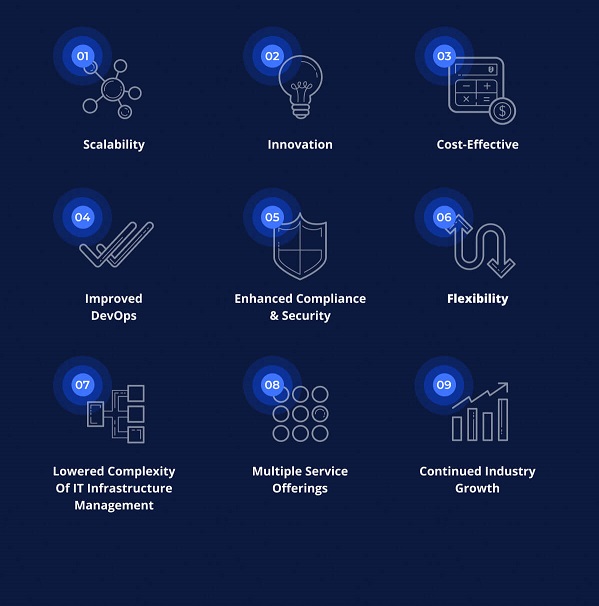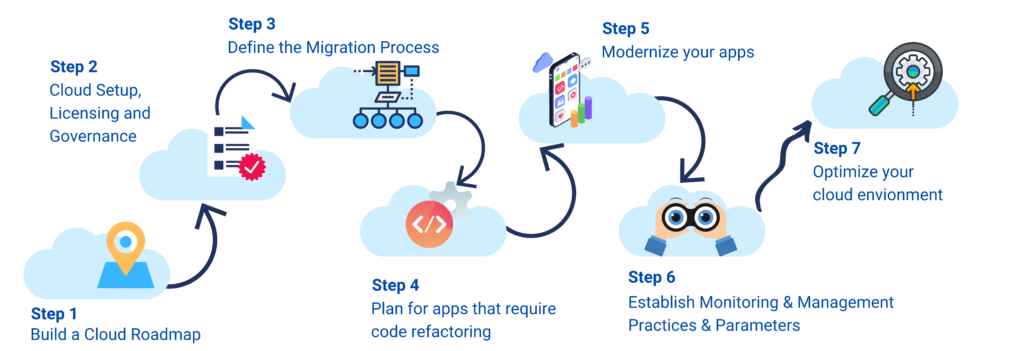
Successful Cloud Migration with Devops Approach
Cloud computing has transcended being a mere buzzword and has evolved into a thriving industry with a global market value of $371 billion, which continues to expand. According to researchandmarkets.com, the market is projected to surpass $832 billion in value by 2025.
Last year witnessed a significant shift in the attitudes of CEOs towards cloud computing. Previously, many CEOs would adopt cloud solutions based on recommendations from their Chief Information Officers (CIOs). However, they have now become enthusiastic about fully embracing cloud computing.
Currently, companies have a remarkable opportunity to accelerate their cloud initiatives. With technology companies reducing their workforce and cutting programs, top talent is becoming available in the job market. It is not just the underperforming employees being let go, but also highly skilled professionals. While these individuals are being quickly hired by other companies, organizations should carefully consider how to swiftly seize the chance to enhance their cloud capabilities.
A research revealed that if a company is still in the process of evaluating whether to adopt cloud migration, it is already lagging approximately 90% of other companies. Moreover, most of these companies are adopting a multi-cloud approach, meaning they utilize multiple cloud platforms. This indicates that cloud adoption has become mainstream, with the majority of enterprise workloads already residing in the cloud.
The Cloud is Changing Security
- Complete situational awareness replaces periodic audits and alerts, enabling organizations to understand their environment comprehensively.
- Secure architecture is prioritized to counter modern cloud attacks that exploit misconfigurations across the entire environment.
- Developers are empowered with resources and knowledge to address security concerns during cloud application development.
- Policy as code (PaC) provides a foundation for secure operations, allowing stakeholders to validate work and adhere to compliance rules.
- Process discipline is maintained by measuring the effectiveness of security technologies and processes in reducing misconfigurations and enhancing developer productivity.
In the past, security was viewed as an obstacle, albeit a crucial one, that impeded progress by requiring the implementation of security measures. In 2022, however, that started to change profoundly prompted by the big commitments companies made in moving to cloud. This shift created a useful forcing mechanism for CIOs and CISOs to rethink security’s role, particularly how to improve the business’ risk posture. Below are the 5 traits:
RELATED: Crucial Role of Employee Security Awareness
The upward trajectory of DevOps driving cloud adoption is expected to gain momentum in the upcoming year, driven by several significant factors. One reason is that organizations are leveraging the cloud migration process to automate security measures. They recognize the opportunity to enhance their security practices by incorporating automation tools and techniques as they transition their applications to the cloud.
Additionally, industries with stringent regulations, such as banking and healthcare are increasingly embracing cloud technologies. This shift prompts regulatory bodies to reassess their focus areas and reconsider the key concerns associated with cloud adoption in these sectors. This evolving perspective from regulators further supports the trend of DevOps driving cloud adoption.
What are the Benefits of Migrating to Cloud?

-
Scalability
Cloud computing offers inherent scalability, enabling businesses to easily and quickly scale their IT solutions.
-
Innovation
Legacy technologies can hinder innovation and the deployment of scalable solutions. Cloud computing provides an infrastructure base for innovation, resulting in improved performance, reduced costs, and increased agility. It enables businesses, especially in the IoT industry, to drive innovation at a rapid pace.
-
Faster Implementation Cycle
Cloud solutions offer faster implementation cycles compared to on-premise software. Instead of waiting months, organizations can go live with cloud products within weeks. Cloud technology facilitates collaboration, enabling teams to access, edit, and share documents and data from anywhere, leading to increased productivity and efficiency. Cloud-based workflow and file-sharing apps provide real-time updates, enhancing the overall implementation process.
-
Cost-Effectiveness
Cloud computing is cost-effective for businesses. While cloud migration may involve initial expenses, it is important to compare current IT spending with future cloud expenses. The value lies in the added functionalities of agility, scalability, and optimized DevOps processes.
-
Enhanced Compliance & Security
Major cloud service providers prioritize security, compliance and data protection. They employ advanced security protocols and adhere to strict regulatory requirements.
-
Flexibility
Cloud computing offers infrastructure flexibility and future-proof capabilities. It allows businesses to scale resources on-demand at a lower cost compared to traditional methods.
-
Lowered Complexity of IT Infrastructure Management
Cloud service providers handle the , enabling organizations to allocate resources to business development and innovation. Moving to the cloud environment provides additional resources for operational scalability.
-
Multiple Service Offerings
Cloud computing offers various deployment and service models. The trend is shifting towards hybrid cloud deployment, combining the advantages of multiple service providers. Service models include Software as a Service (SaaS), Platform as a Service (PaaS), and Infrastructure as a Service (IaaS), providing flexibility and customization options.
-
Continued Industry Growth
Cloud computing has experienced significant growth over the past decade and is expected to continue expanding. Advancements in AI, machine learning, and edge computing contribute to the industry's rapid evolution, impacting businesses across different sectors.
RELATED: Achieving High-Quality Software Development through Quality Assurance: A Comprehensive Guide
What Steps are Involved in Cloud Migration Process?
Having a well-defined cloud strategy is crucial for businesses to effectively scale their capacities and align with their digitalization objectives. As organizations transition from on-premise systems to cloud technology, their cloud migration process will be unique, influenced by their specific business vision, goals, and interests. No two businesses will have the exact same migration approach due to these individual factors. To prepare organizations for a successful cloud migration, here is an industry proven best-in-class cloud migration basic process:

Steps for Cloud Migration
- Define your cloud migration strategy and build a strong business case based on desired outcomes and objectives
- Conduct a thorough discovery and assessment of your existing infrastructure, applications, and data to determine what should be migrated to the cloud and cost of migration is estimated.
- Evaluate your migration costs and needs
- Determine deployment model (IaaS, PaaS & SaaS)
- Choose cloud environment (single or multi-cloud)
- Choose a strong cloud partner
- Choose the right architecture
- Prioritize migration components
- Manage risk by evaluating application performance and considering potential infrastructure changes.
- Execute cloud migration by modernizing existing applications, developing new cloud-native applications, and transforming architecture and infrastructure.
- Utilize automated management and migration tools to ensure a smooth and efficient migration process.
- Implement a robust cloud journey management plan to keep the migration effort on track and aligned with business goals.
What are the Key Considerations for Successful Cloud Migration
Surveys show that even up to 30% of cloud migrations fail. Cloud migrations fail when companies neglect at least a few issues crucial for the process. While migrating to the cloud can bring numerous benefits, there are several common pitfalls that organizations should be aware of to ensure a successful migration. Some of the most common mistakes include:
-
Overwhelming Migration
Instead of migrating all data at once, start with smaller chunks to enable gradual adjustments and ensure systems work effectively.
-
Ignoring Cloud Environment Differences
Each cloud provider has unique infrastructure and applications, so understanding the differences is crucial when choosing a provider or opting for cloud-agnostic solutions.
-
Lack of Business Justification
Before migrating, identify which data, workflows, or applications will truly benefit from the move and assess their ability to deliver the required level of service in the new environment.
-
Neglecting Data and App Adjustments
Many applications require adjustments or replacement with cloud-ready solutions to maximize the benefits of the new infrastructure.
-
Unrealistic Cost Projections
Thoroughly estimate the overall cost of the migration, considering analysis, planning, data adjustments, infrastructure configuration, migration itself, optimization, training, and maintenance.
-
Neglecting Security Considerations
Prioritize security by understanding the cybersecurity services provided by the cloud provider and implementing additional measures to protect your data and infrastructure.
-
Lack of Expertise
Ensure you have a skilled and experienced team to manage the migration process effectively and provide ongoing support for maintenance, problem-solving, optimization, and knowledge sharing.
-
Absence of a Cloud Migration Strategy
Develop a comprehensive strategy that aligns with your company's goals and addresses factors such as global implications, backup procedures, and contingency plans.
-
Ignoring Infrastructure as Code Approach
Adopting Infrastructure as Code (IaC) enables automation, scalability, cost control, and efficient response to changes in the business or technological environment.
-
Neglecting Upgrade Policies
Establish an upgrade policy that allows for seamless upgrades without downtime, utilizing approaches like blue-green deployment or rolling upgrades to ensure uninterrupted service during the upgrade process.
Cloud Computing and the DevOps Approach
According to the 2021 "The State of Cloud-Driven Transformation" report by Harvard Business Analytics Services, organizations have a range of desired outcomes for their cloud investments. The report reveals that 60% of businesses seek increased business agility, while 51% aim for cost reduction or flexibility. Additionally, 38% are looking to accelerate innovation, 37% prioritize accessing and analyzing data for insights, and 35% seek improved systems reliability.
The breadth of these desired outcomes encompasses software development, delivery, and operations. However, realizing these goals can be challenging due to the fragmented ownership and accountability across different teams and departments in organizations. Typically, development, delivery, and operations are separate entities, making it difficult to fully leverage the benefits promised by cloud transformation, despite their extensive documentation and marketing.
Implementing DevOps capabilities and best practices can effectively tackle the challenges and necessary transformations involved in migrating workloads to the cloud. This approach not only supports innovation but also optimizes costs. By fostering collaboration, automation, and continuous delivery, organizations can streamline the migration process, drive innovation, and achieve cost efficiency.
How can KPi-Tech Help
In our experience, businesses that combine DevOps with cloud adoption not only achieve cost savings but also foster innovation. The advantages of utilizing DevOps practices in conjunction with cloud projects are increasingly well-defined and understood. They include application development speed-to-delivery to meet the needs of the business units faster, user demands that they quickly fold back into the software, and lower costs for development, testing, deployment, and operations.
KPi-Tech has spent years perfecting cloud application development and migrating on-premises systems into the cloud. Improve agility and time to market, drive efficiency with Cloud & DevOps solutions for your business.





